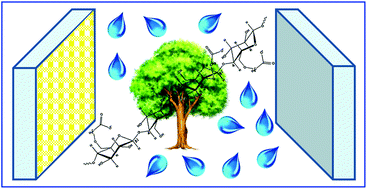Approaching truly sustainable solar cells by the use of water and cellulose derivatives†
Abstract
Aqueous dye-sensitized solar cells (DSSCs) are emerging as the first truly safe, cheap and eco-friendly photovoltaic technology, at the same time overcoming the well-known instability upon moisture/water contamination typical of many solar cells. While many aqueous DSSCs recently proposed still contain little amounts of organic solvents or petroleum-derived polymeric matrices, here we propose the first 100% hydrogel electrolyte, consisting of carboxymethylcellulose as a green jellifying agent, water and iodide/triiodide redox mediator. Electrochemical and photoelectrochemical properties of the resulting electrolytes and solar cells are thoroughly investigated, with a special focus on the long-term stability of the aqueous devices under different operating and aging conditions. The obtained promising efficiencies and stabilities, combined with a metal-free sensitizer, lead here to sustainable, stable, transparent and building-integrable solar cells, without suffering from any safety and/or toxicity issues.

- This article is part of the themed collection: Celebrating our 2019 Prize and Award winners


 Please wait while we load your content...
Please wait while we load your content...